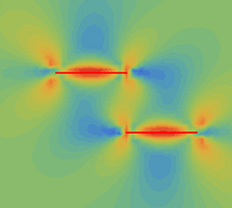The Geomechanics Program targets to tackle Integrated Geomechanics & Reservoir Modeling.

Program Mission & Vision
We conduct original research to develop new tools and methods to study the interaction of (1) fluid flow in porous media, and (2) hydraulic and natural fracture propagation. Our modeling tools quantify and visualize fracturing and flow processes in porous media using coupled codes. Practical applications of our solution methods are in energy extraction engineering (petroleum and geothermal) as well as in subsurface fluid-storage programs (hydrogen, waste fluids, and carbon-dioxide sequestration).
Examples of Research Areas
- Hydraulic Fracture Propagation
- Production Forecasting Multi-fractured Wells
- Wellbore Stability
- Flow in Fractured Porous Media
- Geothermal Well Placement & Flow Models
Our tools and methods are validated using independent computational methods and calibrated with laboratory data and field data. Tailoring our models to applications in specific reservoirs may require detailed input data (such as elastic moduli, rock strength, permeability and diffusivity), for which field logs and laboratory measurements are used.
Program Outcomes
- Practical workflows for drilling and completion technology leading to field-development optimization
- Production-rate forecasting tools for multi-fractured well systems with variable completion designs
- Model tools for hydraulic fracture-propagation from wellbore-perforations outward
- New tools for history-matching real-well production performance
The geomechanics program has access to all of CIPR laboratory facilities.
For example, we have state-of-the-art triaxial-cells, proppant test-cells, as well as CT-scanning devices to monitor flow in cores.
About the Program
Program Mission & Vision
We conduct original research to develop new tools and methods to study the interaction of (1) fluid flow in porous media, and (2) hydraulic and natural fracture propagation. Our modeling tools quantify and visualize fracturing and flow processes in porous media using coupled codes. Practical applications of our solution methods are in energy extraction engineering (petroleum and geothermal) as well as in subsurface fluid-storage programs (hydrogen, waste fluids, and carbon-dioxide sequestration).
Examples of Research Areas
- Hydraulic Fracture Propagation
- Production Forecasting Multi-fractured Wells
- Wellbore Stability
- Flow in Fractured Porous Media
- Geothermal Well Placement & Flow Models
Our tools and methods are validated using independent computational methods and calibrated with laboratory data and field data. Tailoring our models to applications in specific reservoirs may require detailed input data (such as elastic moduli, rock strength, permeability and diffusivity), for which field logs and laboratory measurements are used.
Program Outcomes
- Practical workflows for drilling and completion technology leading to field-development optimization
- Production-rate forecasting tools for multi-fractured well systems with variable completion designs
- Model tools for hydraulic fracture-propagation from wellbore-perforations outward
- New tools for history-matching real-well production performance
Associated Labs
The geomechanics program has access to all of CIPR laboratory facilities.
For example, we have state-of-the-art triaxial-cells, proppant test-cells, as well as CT-scanning devices to monitor flow in cores.
